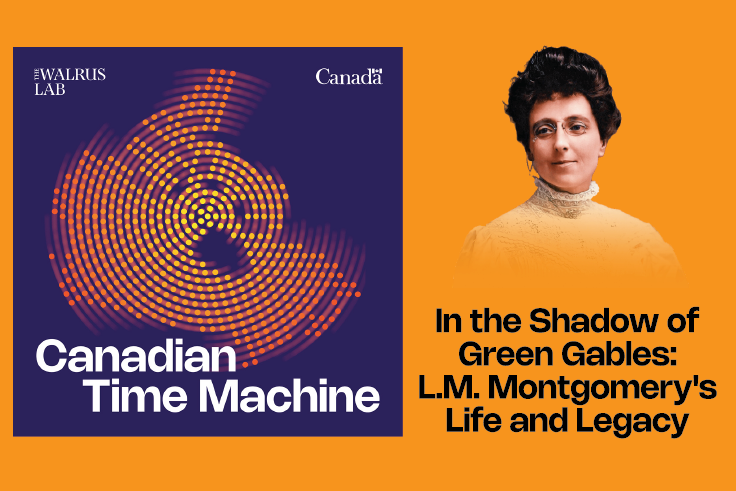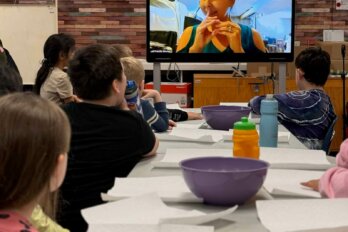It’s been 150 years since Lucy Maud Montgomery’s birth, and her legacy continues to captivate. Best known for Anne of Green Gables, Montgomery crafted characters who embody resilience and imagination. In this special episode, we’re joined by her granddaughter, Kate Macdonald Butler. Kate shares family stories, preserving her grandmother’s legacy, and reads from Emily of New Moon, a novel she considers Montgomery’s most personal work. We also explore Montgomery’s enduring influence, from Anne of Green Gables to the lesser-known Emily, and discuss her life’s challenges, including mental health struggles and the demands of being a minister’s wife. Joining us, Dr. Jessica Katz Edison examines how a 1908 novel continues to resonate with neurodivergent audiences—despite being written decades before the language even existed. This podcast receives funding from The Government of Canada and is produced by The Walrus Lab.
Listen to the episode:
[Clip: “My name is Anne Shirley. Anne spelt with an ‘E.’”]
Angela Misri – It’s an iconic line from the legendary Canadian book, Anne of Green Gables. But what many people don’t realize is that Anne has come to represent a typically underrepresented community.
Welcome to Season Three of Canadian Time Machine, a podcast that unpacks key milestones in our country’s history. This podcast received funding from the Government of Canada and is created by The Walrus Lab. I’m Angela Misri.
This episode is in honour of the 150th anniversary of Lucy Maud Montgomery’s birthday.
She was born in Prince Edward Island in 1874. Montgomery, who liked to be called Maud rather than Lucy, wrote 530 short stories, 500 poems, 30 essays, and 20 novels. A whole slew of them were about a young orphan girl who is said to resemble Montgomery herself. The character’s name was Emily.
Emily of New Moon was the second character that Montgomery wrote extensively about, publishing the first of the series in 1923, well after Anne of Green Gables. Although many believe Anne was meant to represent Montgomery, her granddaughter tells us it’s the character of Emily that most resembled the Canadian literary legend.
Kate Macdonald Butler – (reading) It was so long since Emily had been out for a walk that she was half crazy with the joy of it.”
Angela Misri – That’s Montgomery’s granddaughter, Kate Macdonald Butler. She’s reading an excerpt from the book, Emily of New Moon.
Kate Macdonald Butler – (reading) The winter had been so stormy and the snow so deep that she was never allowed out. April had been a month of rain and wind, so on this May evening she felt like a released prisoner. Where should she go? Down the brook – or over the fields to the spruce barrens? Emily chose the latter. She loved the spruce barrens, away at the further end of the long, sloping pasture. That was a place where magic was made. She came more fully into her fairy birthright there than any other place. Nobody who saw Emily skimming over the bare field would have envied her. She was little and pale and poorly clad. Sometimes she shivered in her thin jacket; yet a queen might have gladly given a crown for her visions, her dreams of wonder.
Angela Misri – You’ll get a chance to hear more from Kate later in the episode. But first, let’s get back to Anne.
Anne of Green Gables is known for being a charming coming of age story with a strong sense of character, defying a lot of the stereotypes for young girls at the time.
Dr. Jessica Katz Edison – When I was younger, my dad used to read me chapter books, and one of the books he read to me is Anne of Green Gables.
Angela Misri – That’s Dr. Jessica Katz Edison, a developmental and behavioural pediatrician at Ascension, Illinois.
Dr. Jessica Katz Edison – I am both a medical doctor, but I was a Theatre Studies major in undergrad, and honestly, what I have closest to is, like, a literary degree in plays. And so I’ve always been really kind of interested in the meld between art and medicine.
Angela Misri – And that intersection led to her co-authoring a research paper about how Anne of Green Gables was an early description of attention deficit hyperactivity disorder.
Dr. Jessica Katz Edison – Certainly, you have multiple examples of her being kind of impulsive. Probably the most famous one is when she cracks her writing palette over Gilbert Blythe’s head.
[Clip: “Anne Shirley, what is the meaning of this?”]Angela Misri – Dr. Edison explains that there were several moments like that throughout the story that depict Anne with hyperactive and inattentive qualities that fit the current definition of ADHD.
But this was way before its time. The book was published in 1908, and ADHD only made its first appearance in the Diagnostic and Statistical Manual of Mental Disorders 60 years later.
Dr. Jessica Katz Edison – And then that obviously gives credence to the idea that, clearly, people were experiencing ADHD symptoms as far back as the early 1900s.
Angela Misri – Online communities have rallied behind this idea, with Reddit threads and op eds from people who identify as neurodivergent and see themselves in Anne Shirley. It’s something her granddaughter, Kate Macdonald Butler, hears a lot from fans in general, but had not heard about this connection in particular. She joins me now in studio. Thanks for being here.
Kate Macdonald Butler – Well, thank you for having me.
Angela Misri – You’re one of several grandchildren, but the only living granddaughter, and you’ve helped produce some of the spinoff movies and shows, and you’re the president of The Heirs of L.M. Montgomery. What’s it like carrying around that legacy?
Kate Macdonald Butler – Well, I sort of feel like a guardian of L.M. Montgomery. It’s a big job, you know? And, you know, I have help. I have helpers. But, you know, I sometimes wrestle with things. And, what would she do? What would she think of this? So, yeah, I have some sleepless nights.
Angela Misri – Well, I have to ask, then what was your reaction when you heard about the ADHD and neurodivergent communities rallying around the character of Anne of Green Gables?
Kate Macdonald Butler – Well, I mean, I think that’s fantastic. I think, you know, whatever helps you get through the day, right? I think it’s just amazing. You know, I think every two years, there’s an international conference at the University of Prince Edward Island, where scholars come from all over the world and give their papers. And I think it would be a fabulous topic for somebody to pick up on, and speak to.
Angela Misri – You know, it’s interesting. I’m a daughter of immigrants, and I found such a connection with Anne of Green Gables myself, so I can totally see why people rally around her. I can see how young people, especially maybe young girls, really see themselves in Anne, and it’s an incredible legacy.
Kate Macdonald Butler – Yeah, and she really crosses the borders, right? You’re not the first person who’s told me that. Even Adrienne Clarkson, our former GG, when she came from China, she said the first book she read was Anne of Green Gables and it gave her a sense of Canada.
Angela Misri – It really does, yeah. So can you tell us a little bit about how you were introduced to this grandmother you never met? Can you tell us a bit about what that was like to hear that, maybe from your father?
Kate Macdonald Butler – I have two older brothers, they’re twins and they’re five years older than I am. So I’m the youngest and I was the girl and I was kind of spoiled in the family. But I had this really nice opportunity. Certainly as a child, my dad read to me, he read Anne of Green Gables to me when I was about 7 or 8 years old. And then of course, I read it later on my own. But this opportunity I had was my brothers were sort of out, launched, gone, and I was studying and sitting at the dining room table.
My mom was a nurse and she worked nights some of the time. So he and I would sit at the dining room table and he would share stories about his mother with me, and I really felt I got him all to myself. Everybody was gone, and it was a really nice chance for me to ask, you know, questions about her. You know, what was she like? And, you know, he told me things like she loved fashion and she loved cooking, gardening and all those kind of domestic things and photography. She was really good. She just did so much. Like, if I could do half as much as she did in her life, I’d be happy.
Angela Misri – You got your dad all to yourself, but you kind of also got her all to yourself.
Kate Macdonald Butler – I did, I did, and because I didn’t meet her, it was really nice. And I was, you know, a young adult at this point in time. And so I was way more interested than when I was a kid. And so I could ask questions about her, you know.
Angela Misri – What a moment. That’s incredible.
Kate Macdonald Butler – It really was. It really was.
Angela Misri – Many people think Anne was a representation of your grandmother Montgomery, but it’s actually her character, Emily, that is said to be much closer to her own personality. I know you never met your grandmother, but can you tell us what she was like and how she relates to this other character, Emily?
Kate Macdonald Butler – Well, you know, Emily is a writer. And, you know, Emily is, I would say, autobiographical, for sure. There are similarities between L.M. Montgomery and Anne, of course, but I think Emily is a little more her personality. It was certainly her favourite book to write, the first one, Emily. Yeah, she really enjoyed that in 1923. You know, it was a little later, the Anne series was over. And, yeah, she had a good time writing that one and was very pleased when it was done.
Angela Misri – I have to say that I was madly in love with Gilbert. So, Anne is my favourite. Sorry. Just letting you know.
Kate Macdonald Butler – Was it the Jonathan Crombie Gilbert?
Angela Misri – It might have been. Yeah, I was exactly the right age to fall in love with him. Can you even imagine your life without Anne of Green Gables?
Kate Macdonald Butler – No! Anne of Green Gables is so a part of my life. It’s, You know, every day I think about Anne of Green Gables, pretty much.
Angela Misri – That’s amazing.
Kate Macdonald Butler – Yeah.
Angela Misri – Mental health issues did play a large role in her life, but she was more so in the caregiver role to her husband—your grandfather. Can you tell us a little bit more about that?
Kate Macdonald Butler – You know, he started to show signs of depression and mental illness when they lived in Leaskdale. And I think it was a really sad time for her. You know, she was a minister’s wife, so she had to keep up the look of a stable family and cover for him a lot of the time.
She was raising two young kids, my dad being one of them. And, you know, my brothers and I, we sometimes think about how sad that must have been for the kids to grow up in that environment where their dad was, you know, clearly not all there.
But I also have to say that I think she also suffered from depression, maybe even from a younger age. But quietly. She was, you know, quietly desperate in her life.
Angela Misri – Sorry. What makes you say that?
Kate Macdonald Butler – Well, if you read her journals, she has some very dark times in her life. But some of them, you know, a lot of them have, have sort of rotated around events. Like, for instance, she lost her second baby, Hugh, and that was a terrible blow to her. And then her very best friend, who happened to be her cousin, Fred, she lost her to the influenza in 1918, and it was another big blow.
And then, of course, her husband Ewan was showing signs of depression and mental illness. And, you know, that was another very difficult time. And I think she was quietly suffering from depression herself.
Angela Misri – I’m just going to ask a question about the journals that you have access to. What can you tell us about those? Because that’s fascinating to me.
Kate Macdonald Butler – Oh, you have access to them, too!
Angela Misri – Oooh!
Kate Macdonald Butler – They were published in the 80s in five volumes.
Angela Misri – Wow.
Kate Macdonald Butler – And since that, and they’re selected. They were selected versions of her writings. And those journals she left to my dad to make sure that he published, or had published. And he sort of set it all in motion and then he died in 1982, so he didn’t really actually see them all published. But yeah, so these journals are available.
And since then, so they’re a selected version of her journals, which were ten volumes.
Angela Misri – Oh!
Kate Macdonald Butler – Yeah. And like, you know, big books that she handwrote in, and I couldn’t read them. You know, her writing was terrible. I just couldn’t decipher it. But since then, they’ve been published. The complete journals have been published as well. So all the missing pieces are there.
Angela Misri – It would be so interesting to read the journals while you’re reading Emily of New Moon or….
Kate Macdonald Butler – Oh, totally. Well, that’s what these scholars do.
Angela Misri – Right! I would assume.
Kate Macdonald Butler – Yes. Yeah.
Angela Misri – Incredible. So Montgomery passed away in 1942 at the age of 67, in Toronto, actually.
Kate Macdonald Butler – And the sad part is that by the end of her life, she was just overcome by depression. In 2008, I shared in The Globe and Mail, an op-ed where I revealed a family secret: that my grandmother had taken her own life. And it was, part of actually, they had done a really fabulous series then, about mental illness and depression, which inspired me to write this piece.
But I also think, you know, depression and mental illness can happen to anyone, including our heroes and heroines. You know, I think the world was shocked when I revealed that she had taken her own life. So it can happen to anybody. It was a cathartic experience for me to deliver that information, because I got a lot of people writing to me saying how much that had helped them in their own depression.
Angela Misri – Yeah, I can see that. How do you think she’d react if she were to see how her stories have stood the test of time?
Kate Macdonald Butler – Well, I really hope she’d be proud of herself. I mean, it’s just remarkable that Anne of Green Gables is still in print, you know, over a hundred years later. Also this year, I don’t know if you’re aware, but the Royal Canadian Mint approached me about doing a commemorative coin, and I have one here for you before I go.
But it’s a $1 coin, and it’s got a little image of Anne and L.M. Montgomery on it, and some of them are colour and some of them aren’t. It came out last month. We launched it in Prince Edward Island at Green Gables House. It was terrific.
Angela Misri – Thank you so much for sharing that with us.
Kate Macdonald Butler – Oh, you’re welcome.
Angela Misri – And thank you for joining us in studio.
Kate Macdonald Butler – Thank you for having me. It’s been, it’s been fun.
Angela Misri – Thank you for listening to Canadian Time Machine. This podcast receives funding from the Government of Canada and is created by the Walrus Lab. This episode was produced by Amanda Cupido and edited by Nathara Imenes. For more stories about historic Canadian milestones and the English and French transcript of this episode, visit thewalrus.ca/CanadianHeritage. There is also a French counterpart to this podcast called Voyage dans l’histoire Canadienne. So if you’re bilingual and want to listen to more, you can find that wherever you get your podcasts.
Angela Misri – Come on in.
Kate Macdonald Butler – Oh, wow.
Angela Misri – Yes, this is my little booth.
[The sound of coins jingling]Kate Macdonald Butler – Here you go, this is your special coin.
Angela Misri – Thank you so much. I am looking at this beautiful coin, blue and green. And it looks like….
Oh, I see, there’s Anne! I see Anne and I see Lucy right next to each other, staring at each other across the blue. Just beautiful. What a beautiful coin. What a beautiful gift. Thank you so much.
Kate Macdonald Butler – You’re welcome!




